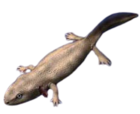Potamotyphlus kaupii: Difference between revisions
Content deleted Content added
m Replace magic links with templates per local RfC - BRFA |
No edit summary |
||
| (23 intermediate revisions by 15 users not shown) | |||
| Line 1: | Line 1: | ||
{{Short description|Genus of amphibians}} |
|||
{{italic title}} |
|||
{{Speciesbox |
|||
{{Taxobox |
|||
| image = Kaup's caecilian.jpg |
|||
| name = ''Potomotyphlus kaupii'' |
|||
| image = |
|||
| status = LC |
| status = LC |
||
| status_system = IUCN3.1 |
| status_system = IUCN3.1 |
||
| status_ref = <ref name=IUCN>{{cite iucn |author=Mark Wilkinson|author2=John Measey|author3= Enrique La Marca|author4= Luis A. Coloma|author5= Santiago Ron|author6= Fernando Castro |name-list-style=amp |year=2010 |title=''Potamotyphlus kaupii'' |page=e.T59589A11955756 |doi=10.2305/IUCN.UK.2010-2.RLTS.T59589A11955756.en |access-date=14 November 2021}}</ref> |
|||
| regnum = [[Animal]]ia |
|||
| genus = Potamotyphlus |
|||
| phylum = [[Chordate|Chordata]] |
|||
| parent_authority = Taylor, 1968 |
|||
| classis = [[Amphibia]] |
|||
| ⚫ | |||
| ordo = [[Gymnophiona]] |
|||
| ⚫ | |||
| familia = [[Typhlonectidae]] |
|||
| range_map = Potamotyphlus kaupii Range.jpg |
|||
| genus = '''''Potomotyphlus''''' |
|||
| genus_authority= |
|||
| ⚫ | |||
| binomial = ''Potomotyphlus kaupii'' |
|||
| ⚫ | |||
}} |
}} |
||
''''' |
'''''Potamotyphlus kaupii''''' (also known as '''Kaup's caecilian''') is a species of [[amphibian]] in the family [[Typhlonectidae]]. It is [[monotypic]] within the genus '''''Potamotyphlus'''''. It is found widely in the [[Amazon Basin]] and [[the Guianas]] in South America,<ref>Oliveira; Meneghell; Messias; Gomes; and Coragem (2012). ''First Record of Potomotyphlus kaupii (Berthold, 1859) (Gymnophiona: Typhlonectidae) for the state of Rondônia, Brazil.'' Herpetology Notes 5: 155-156</ref> and is known to occur in [[Brazil]], [[Colombia]], [[Ecuador]], [[Peru]], [[Venezuela]], and possibly [[Bolivia]].<ref name=IUCN/> It is an entirely aquatic species and typically ranges between {{convert|30|and(-)|60|cm|abbr=on}} in length.<ref name=Vitt>Vitt, L.J.; and Caldwell, J.P. (2013). ''Herpetology, Fourth Edition: An Introductory Biology of Amphibians and Reptiles'', p. 453. {{ISBN|978-0-12-386919-7}}</ref> |
||
Their most common causes of death are dermatitis and skin lesions. The chytrid fungus ''[[Batrachochytrium dendrobatidis]]'', can also threaten them, as it does to many other amphibian biodiversity all over the world.<ref>Flach, E. J., et al. ''Postmortem Findings in Eight Species of Captive Caecilian (Amphibia: Gymnophiona) Over a Ten-Year Period''. 50 Vol. Lawrence, Kan. : American Association of Zoo Veterinarians, 2020. Web.</ref> |
|||
==References== |
==References== |
||
{{Reflist}} |
{{Reflist}} |
||
{{Lissamphibia}} |
|||
* Wilkinson, M., Measey, J., La Marca, E., Coloma, L.A., Ron, S. & Castro, F. 2004. [http://www.iucnredlist.org/search/details.php/59589/all ''Potomotyphlus kaupii'']. [http://www.iucnredlist.org 2006 IUCN Red List of Threatened Species.] Downloaded on 21 July 2007. |
|||
{{Taxonbar|from1=Q2246847|from2=Q15729202|from3=Q49596737}} |
|||
[[Category: |
[[Category:Typhlonectidae]] |
||
[[Category:Monotypic amphibian genera]] |
<!-- [[Category:Monotypic amphibian genera]] removed to genus redirect --> |
||
[[Category:Caecilians of Brazil]] |
|||
[[Category:Amphibians of Colombia]] |
|||
[[Category:Amphibians of Ecuador]] |
|||
[[Category:Amphibians of Peru]] |
|||
[[Category:Amphibians of Venezuela]] |
|||
[[Category:Amphibians described in 1859]] |
|||
[[Category:Taxonomy articles created by Polbot]] |
|||
{{ |
{{Caecilian-stub}} |
||
Latest revision as of 21:58, 6 April 2024
| Potamotyphlus kaupii | |
|---|---|

| |
| Scientific classification | |
| Domain: | Eukaryota |
| Kingdom: | Animalia |
| Phylum: | Chordata |
| Class: | Amphibia |
| Order: | Gymnophiona |
| Clade: | Apoda |
| Family: | Typhlonectidae |
| Genus: | Potamotyphlus Taylor, 1968 |
| Species: | P. kaupii
|
| Binomial name | |
| Potamotyphlus kaupii (Berthold, 1859)
| |

| |
Potamotyphlus kaupii (also known as Kaup's caecilian) is a species of amphibian in the family Typhlonectidae. It is monotypic within the genus Potamotyphlus. It is found widely in the Amazon Basin and the Guianas in South America,[2] and is known to occur in Brazil, Colombia, Ecuador, Peru, Venezuela, and possibly Bolivia.[1] It is an entirely aquatic species and typically ranges between 30 and 60 cm (12–24 in) in length.[3]
Their most common causes of death are dermatitis and skin lesions. The chytrid fungus Batrachochytrium dendrobatidis, can also threaten them, as it does to many other amphibian biodiversity all over the world.[4]
References[edit]
- ^ a b Mark Wilkinson; John Measey; Enrique La Marca; Luis A. Coloma; Santiago Ron & Fernando Castro (2010). "Potamotyphlus kaupii". IUCN Red List of Threatened Species. 2010: e.T59589A11955756. doi:10.2305/IUCN.UK.2010-2.RLTS.T59589A11955756.en. Retrieved 14 November 2021.
- ^ Oliveira; Meneghell; Messias; Gomes; and Coragem (2012). First Record of Potomotyphlus kaupii (Berthold, 1859) (Gymnophiona: Typhlonectidae) for the state of Rondônia, Brazil. Herpetology Notes 5: 155-156
- ^ Vitt, L.J.; and Caldwell, J.P. (2013). Herpetology, Fourth Edition: An Introductory Biology of Amphibians and Reptiles, p. 453. ISBN 978-0-12-386919-7
- ^ Flach, E. J., et al. Postmortem Findings in Eight Species of Captive Caecilian (Amphibia: Gymnophiona) Over a Ten-Year Period. 50 Vol. Lawrence, Kan. : American Association of Zoo Veterinarians, 2020. Web.





